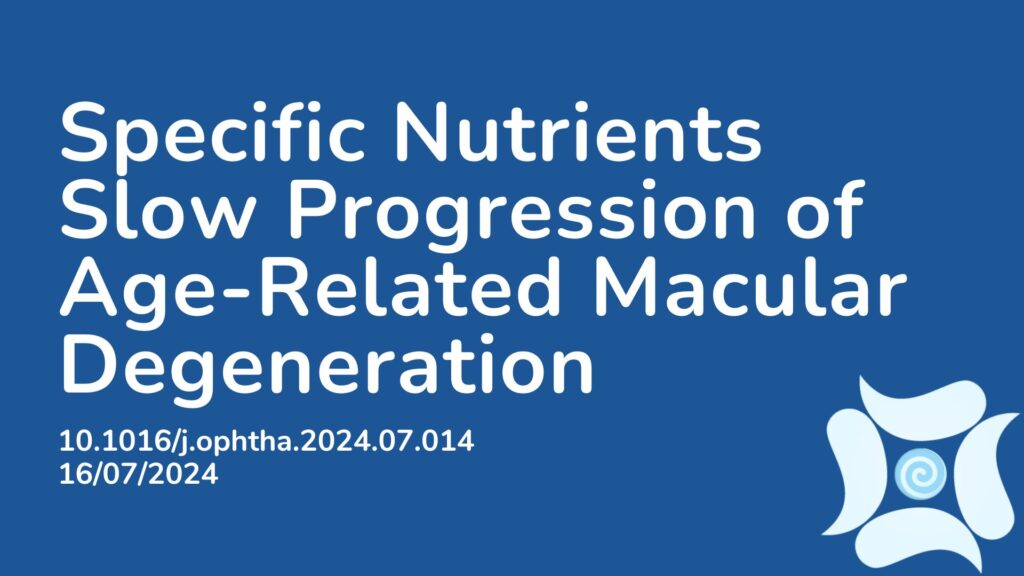Summary:
The purpose of this study was to assess if oral supplements can slow the progression of age-related macular degeneration (AMD), an eye disease that can cause severe vision loss. AMD currently requires frequent and costly intraocular injections. This study analyzes two previous studies, AREDS and AREDS2, which were randomized, placebo-controlled trials. This analysis included 318 participants from AREDS and 891 participants from AREDS2, all with AMD. AREDS participants received supplements containing antioxidants, zinc, or placebo, while AREDS2 participants received lutein/zeaxanthin, omega-3 fatty acids, or placebo. The authors measured AMD progression through changes to the central macula and geographic atrophy area using photographic imaging. Results showed slower AMD progression with antioxidants in AREDS and with lutein/zeaxanthin in AREDS2, concluding that oral micronutrients slowed AMD progression based on central macula imaging.
Abstract:
Purpose: The only treatments approved to slow geographic atrophy (GA) progression in age-related macular degeneration (AMD) require frequent intraocular injection and suffer from modest efficacy, important risks, and high costs. The purpose of this study was to determine whether oral supplements slow GA progression in AMD. Design: Post hoc analysis of the Age-Related Eye Diseases Study (AREDS) and AREDS2, multi-center randomized placebo-controlled trials of oral micronutrient supplementation, each with 2×2 factorial design. Participants: 392 eyes (318 participants) with GA in AREDS; 1210 eyes (891 participants) with GA in AREDS2. Methods: AREDS participants were randomly assigned to oral antioxidants (500 mg vitamin C; 400 IU vitamin E; 15 mg β-carotene); 80 mg zinc; combination; or placebo. AREDS2 participants were randomly assigned to 10 mg lutein/2 mg zeaxanthin; 350 mg docosahexaenoic acid/650 mg eicosapentaenoic acid; combination; or placebo. Consenting AREDS2 participants were also randomly assigned to alternative AREDS formulations: original; no beta-carotene; 25 mg zinc instead of 80 mg; both. Main outcome measures: (1) Change in GA proximity to central macula over time, and (2) change in square root GA area over time, each measured from color fundus photographs at annual visits and analyzed by mixed-model regression according to randomized assignments. Results: In AREDS eyes with non-central GA (n=208), proximity-based progression towards the central macula was significantly slower with randomization to antioxidants versus none, at 50.7 μm/year (95% CI 38.0-63.4 μm/year) versus 72.9 μm/year (95% CI 61.3-84.5 μm/year; p=0.012), respectively. In AREDS2 eyes with non-central GA, in participants assigned to AREDS antioxidants without β-carotene (n=325 eyes), proximity-based progression was significantly slower with randomization to lutein/zeaxanthin versus none, at 80.1 μm/year (95% CI 60.9-99.3 μm/year) versus 114.4 μm/year (95% CI 96.2-132.7 μm/year; p=0.011), respectively. In AREDS eyes with any GA (n=392), area-based progression was not significantly different with randomization to antioxidants versus none (p=0.63). In AREDS2 eyes with any GA, in participants assigned to AREDS antioxidants without β-carotene (n=505 eyes), area-based progression was not significantly different with randomization to lutein/zeaxanthin versus none (p=0.64). Conclusions: Oral micronutrient supplementation slowed GA progression towards the central macula, likely by augmenting the natural phenomenon of foveal sparing.
Article Publication Date: 16/07/2024
DOI: 10.1016/j.ophtha.2024.07.014



